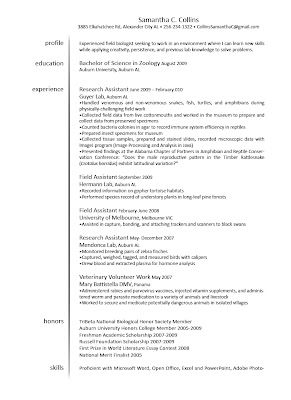Research Assistant in Dr. Craig Guyer's Lab at Auburn UniversityMy most recent work also involved the widest variety of tasks and responsibilities. Several times a week I went into swamps around Lee and Macon county -- often in the Tuskegee National Forest -- to help monitor the local herp populations. This involved checking nets for turtles and salamanders, but primarily hunting for cottonmouths (
Agkistrodon piscivorus) from 8 PM through midnight. Physical measurements were taken from all specimens before they were released, and blood was drawn to test whether the animals were a vector for Eastern Equine Encephalitis.


Auburn also has a large preserved herp collection. I spent many hours in the museum taking measurements and tissue samples to record the seasonal sexual development of male timber rattlers (
Crotalus horridus) and female copperheads (
Agkistrodon contortrix).



Additionally, I embedded organ segments from the timber rattlers in paraffin with a spin tissue processor and made slides with a rotary microtome, which I then dyed, photographed, and measured using the software ImageJ. It was a lot of work, but I enjoyed being a part of the process from field work and sample collection all the way to presentation. The tissue on the right is a slide I made of the sexual segment of the kidney (ssk) -- a specialized reproductive organ found in male squamates.



I was pleased to present my findings to other professionals at
ALAPARC (Alabama Chapter of Partners in Amphibian and Reptile Conservation). Below are just a few of the images showing part of my Excel datasheets, one of several data graphs, and some of the slides from my PowerPoint presentation. You can also see a testes slide I processed and the three measurements I took from structures in that particular tissue.
My presentation discussed the mating patterns of North American rattlesnakes, the physiological markers of these patterns, and how these relate to the information I collected from male timber rattlers (
C. horridus). I used my own findings and examples from other North American rattlesnakes to suggest that their mating patterns were likely a result of phylogenetic constraints rather than the environmental gradient explanation suggested by the Tropical Origins Model (Robert D. Aldridge, David Duvall (
2002) EVOLUTION OF THE MATING SEASON IN THE PITVIPERS OF NORTH AMERICA. Herpetological Monographs: Vol. 16, No. 1, pp. 1-25.).






































 If your institution is looking for a new lab technician or research personnel, I guarantee you will not find anyone more grateful or hard-working. I have the ability to work in any environment, experience in lab and field duties, and the desire to master any skill with determination and creativity. I'm excited to be part of a new project and ready to make your goals my own.
If your institution is looking for a new lab technician or research personnel, I guarantee you will not find anyone more grateful or hard-working. I have the ability to work in any environment, experience in lab and field duties, and the desire to master any skill with determination and creativity. I'm excited to be part of a new project and ready to make your goals my own.